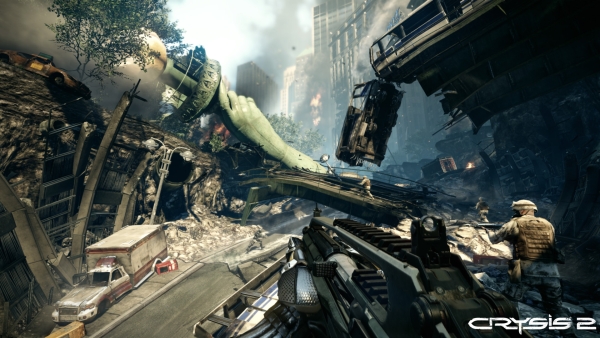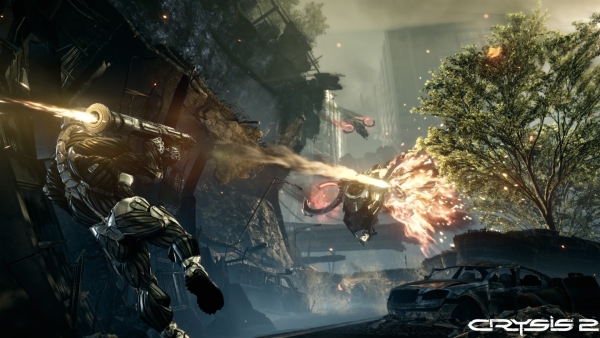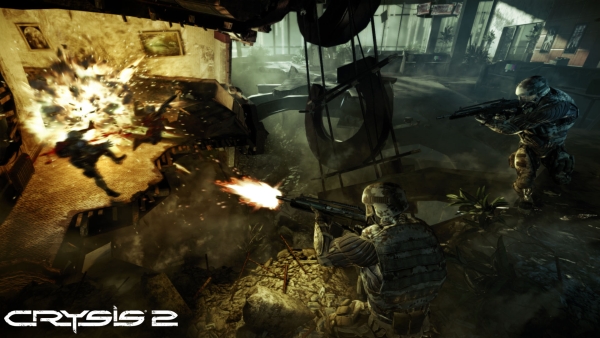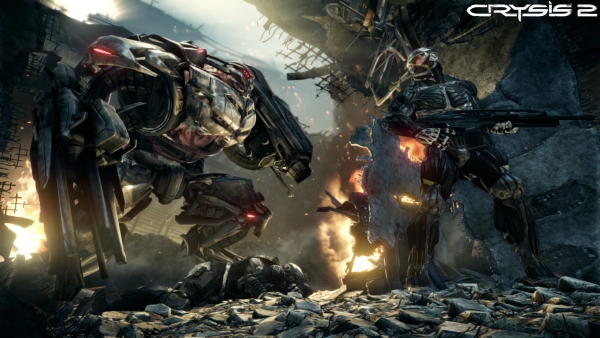
“Can it run Crysis?” For years, this question was the hallmark of determining the mettle of a PC’s prospects as a gaming machine and the bar was so high that the Xbox 360 and even the PlayStation 3 were said to be incapable of running it. Looking to broaden their audience (and possibly clients who license game engines), Crytek unveiled the CryEngine 3, the escort that would bring Crysis to consoles. It’s actually been done; Crysis 2 runs and runs well, but despite its astounding emphasis on visuals, the game fails to stack up well against the FPS heavy hitters of today.
Platforms: PC, PS3 (Version Played), Xbox 360
Publisher: Electronic Arts
Publisher: Crytek
Genre: First Person Conscripted Robocop
Release Date: March 22, 2011
ESRB Rating: Mature
Crysis 2 is the first big disappointment of 2011. Don’t get me wrong – the graphics are incredible, the gameplay is cohesive, the story is functional, and the multiplayer can be addicting. I would even say that this open-ended shooter will resonate strongly with many players. However, all of those rendering techniques and lighting effects didn’t bring a lot of fun along with them, and it’s nearly impossible not to compare Crysis 2 to the dozen or so games that already did what Crytek tried to do before (and better).
The story is arguably the culmination of every cliche that’s been done to death this generation. It’s apocalyptic, it infuses military elements with sci-fi, it takes place in the invaded United States, and tries very hard at times to evoke emotions from players seeing their homeland under siege. New York City is afflicted with an unknown virus, a vague alien invasion is beginning, and a private military company has been called in to maintain stability (read: oppress the civilian population). The game focuses on a US Marine, callsign Alcatraz, who is sent in with his unit to evacuate civilians. Something goes really wrong on their submarine ride in, and after having a near-death experience, Alcatraz is rescued by Prophet, the commander of the Nanosuit-equipped Raptor Team from the first Crysis. He passes the suit onto you before departing, only asking that you find one of his associates and bring the suit to him. Throughout the game, enemies and friendly NPC’s alike mistake Alcatraz for Prophet and, like many video games, little changes once they discern who you really are.
Possibly the greatest embarrassment of Crysis 2 is its almost complete lack of story, further tarnished when the game tries to expound on the plot with its horrible cliches. Granted, plenty of video games fail to tell more than a mediocre story, and many are able to overcome and stand as strong gaming experiences. However, Crysis 2’s writer, the award-winning Richard Morgan, talked a lot of crap about stories in other video games that came out while his was in development. We’re talking a lot of crap. I actually wholeheartedly agreed when he said that Modern Warfare 2 “doesn’t really hang together, it’s just a bunch of mission levels.” You can then imagine the sheer sensation of overwhelming irony I felt to discover that Crysis 2 has arguably less of a plot than Infinity Ward’s last game. There’s hardly any exposition at all, the characters talk in generalities, things just happen and there’s rarely a reason as to why. The plot is paper thin and the characters are bereft of any of the elements that would make them copyrightable forms of expression: they don’t have motives or back stories, they’re simply stand-ins for over-exploited themes.

Perhaps the best example I have of how little the game deals with story is the sequencing of the opening events. You’re shown a series of clips that establish that New York is in chaos. Then you go through the insertion scene of the Marines on the sub, acting like assholes before your near-death experience. You get rescued by Prophet. Then, the credits roll, and it’s supposed to be an awesome montage of all the amazing options the player has with the Nanosuit on the streets of New York. I guess it’s your typical video game credit cutscene. But for the opening “WTF is going to happen next?” moment to be followed by an ultra-masculine rock-and-roll sequence with the badass Nanosuit soldier shooting LMG bullets in slow-mo, one at a time, in a glorious display of testosterone, I just wanted to scream at my television, “What is going on here? Who are these characters? What is up with this suit? Does Crytek have a suit fetish? How is any of this supposed to make sense???”
At one point, I was being given orders by a new character over communications and Warp Zoned Senior Editor Nicole Kline asked me who it was. I had to confess: I honestly did not know. I had no idea. I was able to gather fairly quickly which archetypal mold he fit into, but I didn’t know who he was, why he was helping me, or how he even got my number. It’s just Crysis, I guess.
Of course, Crytek doesn’t hold itself out to be an organization of literary scholars; these are game developers, primarily known for their excellent achievements in graphics. Indeed, one of the title screens says “Achieved with CryEngine 3,” and an achievement it certainly is. I’ve never quite seen a game this realistic, with so much attention to how every object looks, and with such a fantastic use of lighting. However, playing it on a console, there were a few times when I realized I’m just looking at the inferior version of an amazing PC game. Many more times than that, the framerate takes such a hit that the game no longer looks great at all.
Herein lies the ultimate paradox with the original Crysis, and this game as well. Whenever a new console game came out that set a new benchmark for graphics, the PC acolytes would rush into the forums en masse with unfathomable screenshots from Crysis, including comparisons with in-game footage and its real life inspiration that is simply shocking in how close it looks. I’ll always remember one screenshot with the player looking down in a river, seeing hundreds of little pebbles with countless different colors all at his feet. I’ve seen some amazing screenshots of Crysis in my Internet browser, but I’ve never actually seen the unprecedented visuals while running the game.

I’ve seen Crysis and Crysis Warhead at a video game expo in Philadelphia, at a booth of a company who was showing off its newest graphics card. In real life, I’ve never seen Crysis look anything like the screenshots PC gamers love to post. I have no doubt that the shooter that looks far and away better than any title (not called Metro 2033) is out there, but I doubt that the majority of people who played the game actually got it to look like that. And that’s exactly what’s going on with Crysis 2 and its console versions.
It reminds me a lot of PSP development: how studios pull off pretty impressive visuals for such a small handheld, but the game fails to run those visuals well. For all of us who will never get to play this game at its max settings, Crytek has made the ultimate sacrifice in graphics over gameplay. It all looks amazing with your gun at your hip, and even when you aim with a reflex sight. But when you zoom in with a combat scope, or even worse, a sniper scope, everything seems to fade in with each other, much like Grand Theft Auto III did on the PlayStation 2 when looking in first person mode. This can trickle down to other perspectives even in simple firefights, and the giant hectic encounters can be a nightmare. I’ve experienced this all too many times on the PlayStation 3 version, but according to Digital Foundry‘s robust analysis of the game, the Xbox 360 takes an even bigger hit when things get rough. It’s times like these when Crysis 2 stops being one of the best looking games out there.
As if the falling quality in visuals weren’t bad enough, the animations here are painfully substandard. If there’s one common misstep I’ve seen with a lot of PC developers who try to go console, it’s how poor their animations are. Many first person shooters like to take the quiet moments when you’re just following one ally character through a corridor to show off how fluid their characters move as they squeeze between obstacles and duck under obstructions. There are many moments like that in Crysis 2, and they’re pretty unimpressive.
One can look at the quick and simple melee animations to see how little effort was seemingly put into some of them. To see the game at its absolute worst, use the Gunner standard class in multiplayer, pull out the pistol, and aim down the sights. The gun looks like it’s out of a game from 1996, and the firing animation looks even older than that. The framerate issues also plague the movement of some of the vehicles, such as the alien drop ships, which seem to stutter across the sky, apparently from how hard the game struggles to render the red exhaust fumes. Admittedly, many insane things happen with incredibly massive objects throughout the story, and it’s impressive enough to see them occurring even if it does look a little rough. But there are so many less graphically demanding sequences where I just wish the gameplay was running a bit smoother.

And even if it did, the gameplay is not especially strong, either. Crysis 2 styles itself as an open-ended shooter. The player is presented with a linear succession of open environments, scattered with enemies, equipment, and exploitable objects which the player can deal with in nearly any way he or she wishes. You come to each area and use your Nanosuit’s visor to scan for objects, marking each target of interest, including soldiers, ammo crates, the objective, and “tactical options.” The tactical options are hints that the game gives you on how to deal with a specific area, whether it be to throw a grenade into a dense group of enemies, stealth kill a lone soldier, or snipe from a certain position. The Nanosuit itself is designed to present you with plenty of options, as you can cloak yourself to be invisible, use thermal vision to get a better read on targets, increase the power of your bullets, jump at increased heights, and entrench yourself in a thicker layer of armor. All of these abilities drain the short, but rechargable energy bar, so you can’t just walk cloaked in between enemies for the whole level; eventually you’re going to have to find a hiding spot to recharge before it’s too late.
For all of this emphasis on choice, I actually found there to be very little in Crysis 2. For example, with all the bragging about the verticality New York brings to the formula, many areas had few, if any, areas accessible by the super jump. Even when they did, I was still just shooting at enemies like I was before. The secret passages, like sewers, are few and obvious. What makes things worse is that the scant reachable ledges and secret areas are almost always marked by the tactical options. I’m baffled at how the promoters and other reviewers have labeled this game the “thinking man’s shooter” when the Nanosuit does most of the thinking for you. In fact, it almost seems like it does all of the thinking for you, so you can go back to being the simple-minded console shooter fan who likes to see things blow up.
After months of a marketing campaign promising open-endedness, choice, and challenge, Crysis 2 is actually a very scripted, very linear game.
I can’t think of a better aspect of what makes the final product such a far cry from its concept, as well as its strongest competitors, than the enemy AI. Many games came to mind as simply better when I was viewing the inconsistent graphics, disappointing animations, and unimpressive presentation of open-ended gameplay, but the AI is what really hits it home. One member of the Crytek team told me at PAX Prime their enemy AI is undoubtedly the best and smartest in the industry “because it has to be, or else our game doesn’t work,” in regards to all the options the player has with the Nanosuit. Playing the game on normal was a cakewalk. The animations combine with the simple AI to make every encounter as easy as getting the first shot on a target, then making him jitter from side to side and do the Thriller until he’s dead. Even the smarter, deadlier, tougher-to-take-down aliens who were supposed to be more demanding are as easy as walking up to them in plain sight and melee attacking them quickly four times.

The only real challenge I found was keeping my weapons stocked with ammo. But even then, I was able to run out from cover, dash to an ammo box in the middle of all of the enemy fire, restock on ammo, and safely get back to cover. I couldn’t imagine doing this in the campaign of some of the other shooters out there. Sometimes, you’ll also see the enemy walking aimlessly, trying to get through a wall that refuses to let them pass. Another disappointing feature is how easily they can spot you from far distances, sometimes on the other side of the map. Other than that unfair advantage, the enemy AI is so unadaptable, so easy to fell, that it makes the unfulfilled power of choice in the game even less meaningful.
One of the stronger aspects of the game is the multiplayer, but that can also be hit or miss. It carries over all of the capabilities of the Nanosuit from the campaign, and this may be the real area where the game becomes the thinking man’s shooter. With a limited energy supply, you have to be even more careful about when to use cloak, when to use armor, or when to use thermal vision with either of the two or by itself. It seems unmanageable, but the matches can be a lot of fun as everyone’s collectively trying to find and refine their own play style.
The equipment options in the game follow the custom loadout style of online shooters. Players start off with a few standard classes, but then proceed to make their own, selecting what guns and abilities they want to use, then using those in combat to unlock more goodies. I don’t think there are as many potential combinations as the Call of Duty games, but the different Nanosuit abilities interact with each weapon, module (perk), and attachment to really open up the range of play styles. I can’t say if there’s a prestige mode, but there’s enough to dig up to keep you occupied for a long time, and it’s fun enough to keep playing regardless of arbitrary progression and XP.
While there’s no easy AI or sham of a single player concept to worry about here, many of the issues from the campaign obviously carried over. I’ve already discussed how the animations can be disappointing, and some of their worst examples are in multiplayer. The aiming also seems to require a bit more precision as targets can be easily lost. Finally, the graphics are more consistent, but they never get to that level of awe that some of the set pieces provide. Despite these shortcomings, Crysis 2’s multiplayer comes out as fairly strong.
Despite my affinity for the online, I may have painted a pretty bleak picture for the game here. As I said earlier in the review, I have no doubt that many players will develop quite a liking of Crysis 2, and there are plenty efforts here worth commending. For one, the presentation of New York City is an accomplishment all on its own. They really hit it out of the park with their depiction, right down to the ambient feel of the setting, and the urban playground lends itself well to the gameplay, showing Crysis never really left the jungle. The score is rather excellent, especially as a sci-fi story, although the main theme can get a little repetitive. Don’t get me wrong – Crysis 2 is a good game. But it’s not the best looking game on consoles, it’s not the industry’s smartest AI, and the open-ended gameplay is nowhere near as deep, and not nearly as fun, as a few titles over the last few years have been.
One of those games is very much worth bringing up: a game from 2008, developed internally at Ubisoft Montreal. That game was Far Cry 2, the sequel to a franchise that Crytek themselves originally started. Yes, I feel the story on neocolonialism, the consistently beautiful graphics, and the nonlinear narrative all trump Crysis 2’s respective faults. But it’s really the gameplay, the fact that you truly can tackle the large open areas any way you really want to, that shows how far Crysis 2 misses the mark. Crytek’s latest is absolutely a spectacle, but it’s vastly outclassed by what another team did with their own style and franchise… and more than two years ago at that.
I’d still say the game is worth its price of admission. While Crysis 2 doesn’t leap to the front of the pack of world-class shooters, it more than keeps the pace with the rest of them, especially with its superb online multiplayer. The visual presentation is worth seeing for yourself, even if only to say you played it. Just don’t expect the most visceral or challenging experience for your money.

Review Disclosure: A retail copy of Crysis 2 was purchased by Warp Zoned for the purposes of this review.







